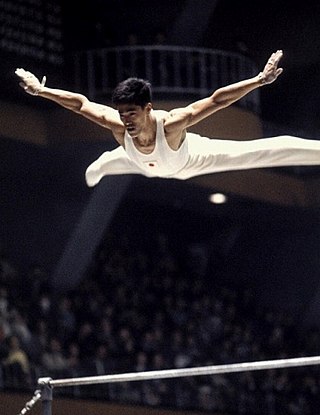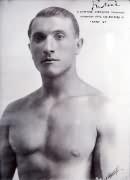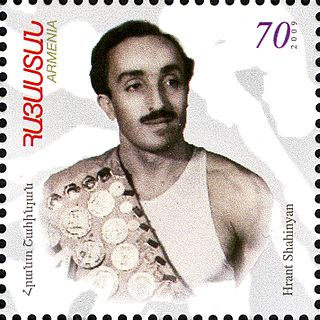
The men's vault was a gymnastics event contested as part of the Gymnastics at the 1964 Summer Olympics programme at the Tokyo Metropolitan Gymnasium. The event was held on 18, 20, and 23 October. There were 130 competitors from 30 nations, with nations in the team competition having up to 6 gymnasts and other nations entering up to 3 gymnasts. For the first time in three Games, there was a clear winner with no tie. Haruhiro Yamashita took the gold medal, the second consecutive gold for Japan. Victor Lisitsky finished second, taking silver but breaking the Soviet Union's three-Games gold medal streak. Hannu Rantakari's bronze was Finland's first medal in the event since 1948.

The men's parallel bars was a gymnastics event contested as part of the Gymnastics at the 1964 Summer Olympics programme at the Tokyo Metropolitan Gymnasium. The event was held on 18, 20, and 23 October. There were 128 competitors from 29 nations, with nations in the team competition having up to 6 gymnasts and other nations entering up to 3 gymnasts. The event was won by Yukio Endo of Japan, the nation's first victory in the parallel bars after two Games with silver and bronze medals. It was the first of a four-Games gold medal streak for Japanese gymnasts in the event. Japan also took silver, with Shuji Tsurumi finishing second. Bronze went to Franco Menichelli of Italy.

The men's horizontal bar was a gymnastics event contested as part of the Gymnastics at the 1964 Summer Olympics programme at the Tokyo Metropolitan Gymnasium. The event was held on 18, 20, and 23 October. There were 128 competitors from 29 nations, with nations in the team competition having up to 6 gymnasts and other nations entering up to 3 gymnasts. The event was won by Boris Shakhlin of the Soviet Union, the nation's first victory in the horizontal bar after two Games with silver and bronze medals. The Soviets also took silver, with Yuri Titov finishing second. Shakhlin and Titov were the fifth and sixth men to win multiple medals in the horizontal bar. Bronze went to Miroslav Cerar of Yugoslavia.

The men's artistic individual all-around event was part of the gymnastics programme at the 1932 Summer Olympics. It was the eighth appearance of the event, which was established in 1900. The competition was held from Monday, August 8, 1932, to Wednesday, August 10, 1932. Twenty-four gymnasts from five nations competed. Each nation could enter a team of 5 gymnasts; Hungary sent only 4. The event was won by Romeo Neri of Italy, the nation's first victory in the event since 1920 and fourth overall. István Pelle of Hungary took silver and Heikki Savolainen of Finland earned bronze; it was the first medal in the event for each nation.
These are the results of the women's Uneven Bars competition, one of six events for female competitors in artistic gymnastics at the 1968 Summer Olympics in Mexico City.

The men's horizontal bar competition was one of eight events for male competitors in artistic gymnastics at the 1960 Summer Olympics in Rome. It was held on 5, 7, and 10 September at the Baths of Caracalla. There were 130 competitors from 28 nations, with nations in the team competition having up to 6 gymnasts and other nations entering up to 2 gymnasts. The event was won by Takashi Ono of Japan, the nation's second consecutive victory in the men's parallel bars. Masao Takemoto gave Japan a second medal with his silver. Ono and Takemoto were the third and fourth men to win multiple medals in the parallel bars; Ono was the first to win two gold medals in the event. Boris Shakhlin of the Soviet Union took bronze.

The men's vault competition was one of eight events for male competitors in artistic gymnastics at the 1960 Summer Olympics in Rome. It was held on 5, 7, and 10 September at the Baths of Caracalla. There were 129 competitors from 28 nations, with nations in the team competition having up to 6 gymnasts and other nations entering up to 2 gymnasts. For the second straight Games, there was a tie for first place in the vault. Boris Shakhlin of the Soviet Union and Takashi Ono of Japan each received a gold medal. It was the third consecutive Games with a gold medal for the Soviets. Ono, who had taken bronze in 1952, became the second man to win multiple vault medals. Third place and the bronze medal went to Soviet Vladimir Portnoi.
These are the results of the women's floor competition, one of six events for female competitors in artistic gymnastics at the 1960 Summer Olympics in Rome.

The men's parallel bars competition was one of eight events for male competitors in artistic gymnastics at the 1960 Summer Olympics in Rome. It was held on 5, 7, and 10 September at the Baths of Caracalla. There were 129 competitors from 28 nations, with nations in the team competition having up to 6 gymnasts and other nations entering up to 2 gymnasts. The event was won by Boris Shakhlin of the Soviet Union, the nation's second consecutive victory in the men's parallel bars. Giovanni Carminucci earned Italy's first medal in the event since 1932 with his silver. Takashi Ono of Japan took bronze for a second consecutive Games, making him the fourth man to win multiple medals in the event.
These are the results of the women's uneven bars competition, one of six events for female competitors in artistic gymnastics at the 1960 Summer Olympics in Rome.
These are the results of the women's balance beam competition, one of six events for female competitors in artistic gymnastics at the 1960 Summer Olympics in Rome.
The women's artistic team all-around competition at the 1948 Summer Olympics was held at Earls Court Exhibition Centre on 13 and 14 August. It was the third appearance of the event.
The men's artistic team all-around competition at the 1952 Summer Olympics was held at the Messuhalli, Exhibition Hall I on 19 and 21 July. It was the tenth appearance of the event.
The women's artistic team all-around competition at the 1952 Summer Olympics was held at Messuhalli, Exhibition Hall II on 22–24 July. It was the fourth appearance of the event.

The men's artistic individual all-around competition at the 1952 Summer Olympics was held at Messuhalli, Exhibition Hall I from 19 to 21 July. It was the eleventh appearance of the event. There were 185 competitors from 29 nations. Each nation entered a team of between five and eight gymnasts or up to three individual gymnasts. The event was won by Viktor Chukarin of the Soviet Union, with his countryman Hrant Shahinyan taking silver. It was the Soviet debut in the event, beginning four decades of dominance rivalled only by Japan and ending after the dissolution of the Soviet Union; the Soviets would win 6 of the 10 editions from 1952 to 1988, with Japan taking the other 4. Bronze in 1952 went to Josef Stalder of Switzerland ; it was the last medal in the men's all-around for any gymnast not from the Soviet Union or Japan until 1980.
The women's artistic individual all-around competition at the 1952 Summer Olympics was held at Messuhalli, Exhibition Hall II from 22 to 23 July. It was the first appearance of the event.
The men's floor exercise competition at the 1952 Summer Olympics was held at Messuhalli, Exhibition Hall I from 19 to 21 July. It was the fourth appearance of the event.
The women's floor exercise competition at the 1952 Summer Olympics was held at Messuhalli, Exhibition Hall II from 22 to 23 July. It was the first appearance of the event.
The women's balance beam competition at the 1952 Summer Olympics was held at Messuhalli, Exhibition Hall II from 22 to 23 July, 1952. It was the first appearance of the event, though balance beam exercise were part of the women's team all-around events in 1936 and 1948.
The women's vault competition at the 1952 Summer Olympics was held at Messuhalli, Exhibition Hall II from 22 to 23 July. It was the first appearance of the event, though vault exercises were part of the women's team all-around events in 1928, 1936, and 1948.







